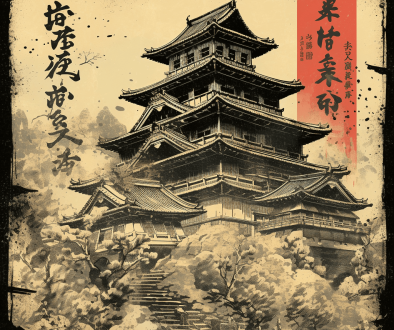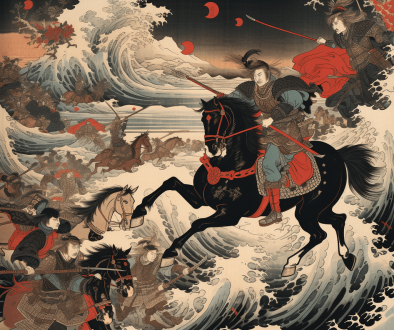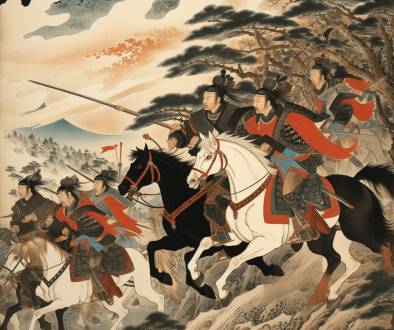Courtly Defiance: The Samurai Uprising of Taira no Masakado in Heian Japan
Heian Japan was marked by the rise of powerful warlord families, known as “bushi,” throughout its countryside. The Taira was one such powerful warlord family, and among its members was Taira no Masakado, a provincial magnate and samurai who amassed power by storming his rivals’ territories, eventually claiming eight northern provinces.
The Shōmonki records his story as a captivating yet tragic account of how one individual became embroiled in regional instability and violence.

The Heian Era: Japan’s Age of Courtly Refinement
During the Heian period (794-1185 CE), particularly around 939-940 CE, warrior classes made steady gains in political power. While nominal sovereignty rested with the imperial family, true powers lay with influential families like the Fujiwara clan, which intermarried with the imperial family and used their influence to control the court. In the later years of the Heian period, wealthy samurai families began to amass power and private armies.
Taira no Masakado belonged to the Taira clan, one of Japan’s most potent clans then. The Kanmu Taira, after some political maneuvering, found themselves in an uncertain situation.
Masakado initiated a rebellion against the central government to end his struggles, an event that became known in Japanese as the “Johei Tengyo no Ran” or simply “Tengyo no Ran.” His revolt began on 25 March 940 CE and ended when Masakado was beheaded during the Battle of Nomoto by Hidesato; his head is now resting in the Otemachi district of Tokyo’s Kubizuka (head grave). This tale of rebellion and revenge highlights the shifting dynamics of regional power; the insurrection led by Taira no Masakado was a pivotal event in the evolution of medieval Japan.
Taira no Masakado: The Rise of a Regional Power
Masakado was raised as part of the Taira clan, which traced its lineage back to Emperor Kanmu. However, due to unclear inheritance laws at the time, when his father passed away, his uncles attempted to take possession of his land.
In light of Masakado’s actions and growing influence, the central government viewed him as a potential threat, condemning him as a traitor and demanding action against him.
In 939, Masakado led his army to attack an outpost of the central government in Hitachi Province, captured its governor, and took control of the Shimotsuke and Kozuke Provinces. Additionally, he declared himself as “Shinno,” often translated as “new prince” or “prince of the blood.”
Masakado was an influential warlord who expanded his territorial control. Many peasants in his acquired territories saw him as a protector against the central authority, and it’s believed that he garnered their support by treating them with more fairness compared to previous regional rulers.
While his rebellion was a significant concern, the court also grappled with multiple challenges, including natural disasters in the northeast, banditry in the capital region, and piracy to the west, which might have affected their immediate response to Masakado. To quickly end Masakado’s uprising without directly interfering, they ordered their soldiers to hunt him down, eventually finding him near what would become Tokyo in Shibasaki village near where Tokyo ultimately was founded.
The Rebellion Ignites: Masakado’s Claim to Power
Masakado’s rebellion, ignited by his clash with various regional figures, marked a significant moment in Japan’s early samurai history. It showcased the growing influence of provincial warlords, a trend that would become prominent, especially in the later Sengoku period.

Masakado distinguished himself among his samurai peers through his multifaceted talents and roles, providing him with a foundation in political and military affairs that served him well in his later endeavors.
In the mid-930s, conflicts arose between Masakado and some members of the Taira clan, including Taira no Yoshikane. Despite these tensions, Masakado was pardoned by the Kyoto imperial court and even received a warrant to apprehend Yoshikane and Sadamori.

However, despite receiving a warrant, circumstances changed, and Masakado conflicted with the central authorities. His eventual death came at the hands of his rivals near Shibasaki. His legacy remains alive as his tomb is in the Otemachi area of modern-day Tokyo, and there’s a Taira no Masakado-jinja shrine near Tokyo Station. You can visit.
The Central Authority’s Response: Masakado’s Fall
The central authority was faced with challenges from regional figures like Masakado and, separately, Sumitomo. While these figures led powerful factions, direct confrontation wasn’t always the preferred method of the central government; sometimes, more diplomatic measures were deemed necessary.
Masakado clashed with various regional figures, including members of the Taira clan, in different locations. In these conflicts, Masakado managed to repel many of his adversaries, leading to casualties on both sides.
Later, Masakado became involved in disputes with local and central figures, which led to him being charged with misconduct by the central authorities. While Masakado faced further challenges from figures like Yoshikane and Sadamori, he successfully defended himself. However, the broader Taira clan was under scrutiny and blame during this period of conflict.
Natural phenomena, like an earthquake and unusual events in Kyoto, were sometimes interpreted by diviners as omens. These interpretations may have influenced perceptions and actions regarding figures like Masakado. Masakado’s head was indeed interred in Shibasaki, now within the modern Tokyo city limits.
The Legacy of Taira no Masakado
Taira no Masakado was an intricate figure. As a cultural aristocrat by training, his actions hinted at aspirations for independent rule, even if he did not formally claim the title of Emperor. He led rebellions against the central government – in doing so, eliminating many blood relatives while helping establish powerful warlord families across Japan’s provinces.
Early in his life, he was part of the Taira clan, descended from Emperor Kanmu, and had his upbringing in the Kanto region. Later he moved to Shimosa province, northeast of modern-day Tokyo, where inheritance laws weren’t very established; here, his uncles attempted to steal much of his land.
Masakado had become embroiled in an intense feud with his family members, and its attendant raids and counterraids ultimately culminated at his home in Iwai City, Shimosa province, when Yoshikane and Mamoru, two figures in opposition to him, surrounded the compound with troops. Masakado took significant military actions, intending to assert his regional power.
Masakado’s insurrection involved several confrontations and power dynamics, but specific actions like capturing and torturing the wives of notable figures need further verification. Additionally, his rebellion had significant consequences across the region. Legend has it that, following his death, his head was found on a hill near Shibasaki village (the area that would later become Edo or Tokyo). A shrine was subsequently built in his memory, known as Kubizuka, and some believe that his spirit still haunts this area today.
Repercussions and Reflections on Heinan Period
Masakado’s story dramatically illustrates the changing power dynamics during the Heian period in Japan. It shows how even an influential warrior clan can succumb when their destiny becomes unpredictable.
Masakado was born into the Taira clan, which had ties to Emperor Kanmu. After spending his early childhood years in Shimosa Province, northeast of modern-day Tokyo, Masakado later relocated here when inheritance laws weren’t clear-cut, and his uncles attempted to take control of his land from him.
He disobeyed court summons and instead raised an army, attacking enemy lands and eventually taking eight provinces under his control – becoming widely seen by his peers as a potential ruler.
In 939, Masakado successfully defended against attacks by Yoshikane and Sadamori, though he could not capture either. In the 940’s battle, Masakado faced off against Yoshikane’s combined forces.
Despite his acts of rebellion, Masakado’s relationship with the Imperial Court and the consequences he faced show the complex dynamics between the central authority and regional power figures during that period.



